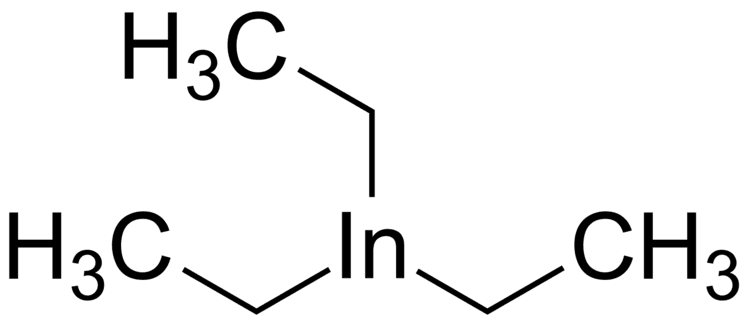Formula InC3H9 Density 1.57 g/cm³ Appearance White, opaque crystals | Molar mass 159.922 g/mol Boiling point 135.8 °C | |
 | ||
Trimethylindium (abbr: TMI or TMIn), In(CH3)3, (CAS #: 3385-78-2) is the preferred organometallic source of indium for metalorganic vapour phase epitaxy (MOVPE) of indium-containing compound semiconductors, such as InP, InAs, InN, InSb, GaInAs, InGaN, AlGaInP, AlInP, AlInGaNP, etc. TMI is a white, crystalline and sublimable solid, with melting point 88 °C. TMI is pyrophoric (ignites spontaneously upon contact with air), and its decomposition is often found to be uncontrollable as the temperature of its surrounding exceeds its melting point (i.e. > 88 °C) and reaches 101 °C and above. TMI is also reported to exhibit autocatalytic behavior during its thermal decomposition. TMI therefore needs to be handled with the utmost care and caution, e.g. stored in preferably cool, dry place at 0-25 °C, and operating temperatures under 50 °C in order to avoid deterioration. TMI also reacts extremely violently with oxidizers and polyhalogenated compounds (such as CCl4 or CBrCl3), with which TMI is therefore incompatible. Hence, mixtures of TMI with oxidizers and/or polyhalogenated compounds must be avoided as they are potentially dangerous and explosive.
Contents
Preparation and Reactions
Trimethylindium, InMe3 can be produced by reacting InCl3 in diethyl ether solution either with the Grignard reagent, MeMgI, or methyllithium, LiMe.
InCl3 + 3LiMe → Me3In.OEt2 + 3LiClInCl3 + 3MeMgI → Me3In.OEt2 + 3MgClIthe ether is removed at 25 °C in vacuoInMe3 is a Lewis acid, weaker than trimethylaluminium, AlMe3 and trimethylgallium, GaMe3. It forms adducts with secondary amines and phosphines. A complex with the heterocyclic triazine ligand PriN(CH2)3 forms a complex with 6 coordinate In, where the C-In-C angles are 114°-117° with three long bonds to the tridentate ligand with N-In-N angles of 48.6° and long In-N bonds of 278 pm.
Structure
In the gaseous state InMe3 is monomeric, with a trigonal planar structure, and in benzene solution it is tetrameric. In the solid state there are two polymorphs, a tetragonal phase which is obtained, for example, by sublimation and a lower density rhombohedral phase discovered in 2005, when InMe3 re-crystallised from hexane solution.
In the tetragonal form InMe3 is tetrameric as in benzene solution and there is bridging between tetramers to give an infinite network. Each indium atom is five coordinate, in a distorted trigonal planar configuration, the three shortest bonds,(ca. 216 pm ) are those in the equatorial plane, with longer axial bonds, 308 pm for the In-C bonds joining the InMe3 units to form the tetramers and 356 pm for the In-C linking the tetramers into an infinite network. The solid state structures of GaMe3 and TlMe3 are similar. The association in the solid state accounts for the high melting point of 89°-89.8 °C compared to triethylindium which melts at -32 °C.
The rhombohedral form of InMe3 consists of cyclic hexamers with 12 membered (InC)6 rings in an extended chair conformation. The hexamers are interlinked into an infinite network. Indium atoms are five coordinate the equatorial In-C distances average 216.7pm almost identical to the average for the tetragonal form, and the axial bonds are 302.8pm joining the InMe3 units into hexamers and 313.4 pm linking the hexamers to form the infinite network.
Semiconductor grade TMI
The advancements in synthesis and purification chemistries have now made it possible to attain highest purity in TMI (99.9999% pure or greater), which is imperative for improved performance of semiconductor applications. Recent reports indicate some of the best electrical properties for InP alloys so far, by MOVPE using highest purity TMI available today, e.g. electron mobilities (Hall data) as high as 287,000 cm²/Vs at 77 K and 5400 cm²/Vs at 300 K, and background carrier concentration as low as 6×1013 cm−3, which were not practically achievable in the past.
Accurate vapor pressure equation for TMI
The vapor pressure equations reported in the literature for TMI have been found to offer overestimated vapor pressure of TMI, often by as much as 20–40%. Not knowing the accurate vapor pressure has thus been a concern to crystal growers. In a recent study, it was experimentally confirmed that the vapor pressure equation, log P (Torr)=10.98–3204/T (K), provides the most accurate vapor pressures of TMI within a wide range of MOVPE growth conditions.
